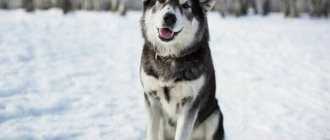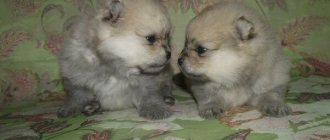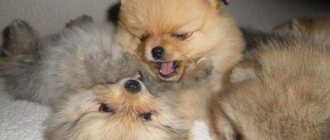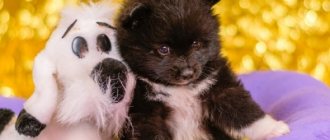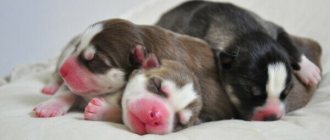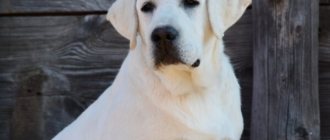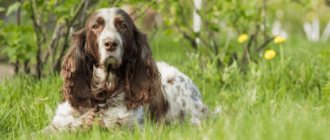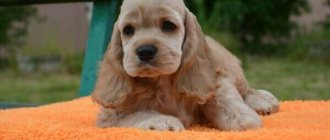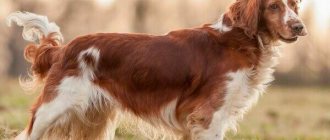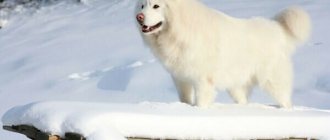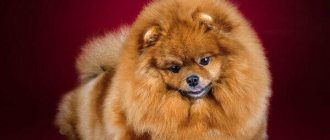Depending on their color, huskies can look like one or another wild predator.
For example, a red husky looks like a fox.
The similarity with this furry predator is enhanced by the fact that these dogs, like foxes, are very smart, cunning and, at the same time, inquisitive animals.
And their wool, sparkling with gold or copper, invariably impresses both passers-by on the streets and exhibition experts.
Origin story
The history of Siberian huskies begins in ancient times, when the tribes that lived in the Far East of Russia, which are classified as the so-called “Okhotsk culture,” needed to move to new lands .
For this purpose, a strong, hardy and unpretentious sled dog breed was bred. From this breed, called the “Chukchi sled dog,” came not only Siberian huskies, but also Samoyeds and Malamutes.
The Chukotka sled dog is not recognized by the FCI and is currently considered rare, however, these dogs still continue to be bred in some settlements of Chukotka, where they are used for transporting goods, as well as hunting sea animals.
Husky, being descendants of representatives of this very ancient breed, along with strength, endurance and performance, inherited most of the colors inherent in the ancient Chukchi sledding breed, including red and its various variations.
At the beginning of the 20th century, when dogs from Chukotka were brought to Alaska, where red huskies, like dogs of all other possible colors, helped people deliver goods to remote settlements.
After the recognition of the breed, dogs of this color began to be used as companions and are now very popular among both ordinary owners and professional breeders.
What is the reason for the variety of colors?
Husky was bred by the peoples of the Far North based on local dogs and wolves. Selection for many centuries was carried out on the principle of selecting the most hardy and efficient individuals that can easily withstand harsh climatic conditions. They not only have to run in a harness, but also sleep in the snow. That is why minimal attention was paid to appearance, and the closest attention was paid to working qualities and health. This is how huskies of different colors appeared.
According to the standard approved by the IFF, the color can be anything from white to black. Different colors in all possible combinations, marks on the body or their complete absence are acceptable.
In the Russian Federation, the approach to this issue is more conservative - white color or its combination with black, gray or brown is considered the standard. But the rest of the colors are not considered a marriage, especially since Khasenys have such individual colors that it is extremely difficult to find two absolutely identical puppies.
Marriage or breed?
Neither the red color, nor the coat colors derived from it, can be considered a defect in the breed . However, it is necessary to take into account that there are no pure red dogs of this breed without white markings.
Expert opinion
Kozhevin Semyon Kirillovich
Expert dog handler.
“The red husky with fur that shimmers in the sun with all shades of gold and copper is an incredibly beautiful and harmonious dog. Due to the color and shape of the tail, from a distance it can be mistaken for a fox, the resemblance to which is also given to this dog by such character traits as intelligence, intelligence, cunning and curiosity. The red husky will make a wonderful pet - playful, friendly and very loyal. And its bright color will not only impress others, but will also cheer up the owners even on the cloudiest autumn day.”
Puppy price
The cost of a puppy depends more on what your needs are. If you want to find and purchase a purebred Japanese Husky baby, then you will have to work hard. This breed is now quite rare and is often mixed with other species.
Reputable nurseries will not ask for a large sum for a puppy, but do not forget that its cost will also depend on the natural talents and external characteristics of the baby.
Bright color, involvement in the show class and the presence of medals from the parents can raise the price to seventy thousand rubles. A puppy without any special differences, but meeting all breed standards, will cost about forty thousand rubles and will be able to continue its family line and participate in breeding.
Character traits
Red huskies are distinguished by their lively, but at the same time, friendly and calm disposition. They are smart, quick-witted, and with the right approach to training, they remember new commands well.
These dogs are good with children and willingly play with them, however, you should not trust a child with raising and training a husky, as representatives of this breed tend to be stubborn and can even become disobedient.
Red huskies are able to adapt to different living conditions and are suitable for both outdoor and indoor living.
NOTE!
These dogs are not naturally vicious towards strangers, which is why they are not suitable for the role of guards for a house or apartment.
Huskies also make bad hunters: they have a hunting instinct, which is why these dogs can catch small animals, for example, rodents or poorly flying birds, but they will not give the prey to the owner, but will try to eat it before he has time to stop them .
Positive and negative properties
Of course, you need to look for only positive aspects in all dogs, the red husky is one of the most beautiful dog breeds, and this is probably one of the main positive properties, but let’s still talk in more detail about the positive and negative properties of the red husky.
Positive properties of red huskies
- stunningly soapy appearance;
- devoted to family;
- intelligent and gentle nature;
- excellent endurance;
- big personality;
- a lot of energy.
Negative properties
- useless as a guard dog;
- Howls, does not bark (but not much);
- behaves poorly if left alone;
- maintenance requires a large fenced area;
- will chase small animals if she is bored;
- not good in a sedentary environment, requires activity;
- needs regular brushing.
© shutterstock
Advantages and disadvantages
pros:
- Beautiful and bright appearance.
- Friendly character.
- Lack of aggression towards people.
- Intelligence, intelligence and good learning ability.
- Love for children.
- Playful and cheerful disposition.
- Loyalty to the owner.
- Endurance and ability to adapt to different living conditions.
- Unpretentiousness in food and maintenance.
- It can live either in the courtyard of a private house or in an enclosure with a booth, or in an apartment.
Minuses:
- Excessive trusting of strangers.
- Hunting instincts, due to which the dog can be dangerous to other smaller pets.
- The need for increased physical and mental stress.
- Tendency to be self-willed and stubborn from time to time.
- They can howl or damage things in the absence of their owners.
- Predisposition to escape.
- They love to dig up the ground and can create a tunnel.
Dimensions, weight and other distinctive features
| Options | Description |
| Dimensions | Males - 53.5-60 cm Bitches - 50.5-56 cm |
| Weight | Males - 20.5-28 kg Bitches - 15.5-23 kg |
| Body Format | Rectangular, tending to square, in which the length of the body exceeds the height at the withers by no more than 3 cm. |
| Head | Not coarse, but not overly refined, with a moderately wide skull and a muzzle of medium volume, the length of which is equal to the skull. |
| Ears | Set quite high. Medium size, erect, triangular with slightly rounded tips. |
| Eyes | Brown, amber, golden, blue or with heterochromia, almond-shaped, moderately widely spaced. |
| Nose | Most often, it is brown or liver-colored. |
| Neck | Medium length, muscular and slightly arched, should not look too bulky nor thin and weak. |
| Rib cage | Moderately powerful and quite deep. |
| Limbs | The front ones are straight, parallel, not too wide apart. The hind legs have well-defined joint angles and moderately muscular thighs. |
| Tail | In a calm state it is lowered down, when excited it rises up and is held above the back in the form of a well-furred sickle. |
| Wool | Moderately long, but very thick and dense. The guard hair is coarser than the undercoat, which, moreover, can be of a different color, for example, cream or grayish. |
A red husky's tail should resemble a fox's and should never be curled into a ring..
Quick Facts About the Red Husky
| Size | From 45 to 55 cm (females) and from 50 to 60 (cables) |
| Weight | From 15 to 20 kg (females) and from 20 to 27 kg (cables) |
| Lifespan | From 12 to 14 years |
| Breed type | working group |
| Purpose | sled pull |
| Suitable for | active and experienced owners |
| Color | redhead (but there are others) |
| Temperament | freedom-loving, friendly, hardworking, loyal and stubborn |
| other names | Red Siberian Husky |
Shades of red
- Ginger . The clean and bright coat color of these dogs usually has a well-defined copper or golden tint. With this color, there must be at least one small white spot.
- Fawn . More like a beige or dark cream shade.
- Copper . When looking at such dogs, it is not always possible to determine whether they are red or brown, so, in fact, this shade can be considered transitional.
- Red and white . With this color, the main color of the coat is red, fawn or copper with rather large white spots located on it, usually located on the forehead, muzzle, cheekbones, neck, chest, lower limbs, on the stomach, inside the ears and on the tail.
- Piebald . Small spots of reddish hues are scattered across the predominant main white background.
- Splash . On the back, tail and head of these huskies there are large red, fawn or copper-colored spots, which from a distance resemble a mantle thrown over the animal’s back.
- Soboliny . Lighter hairs, reddish at the base, darken to black or brownish towards the tips.
- Isabella . It resembles sable, but the fur is white and only the tips of the guard hairs are colored reddish.
With most red colors, huskies have a light mask on the face and a trefoil pattern on the forehead, characteristic of representatives of this breed.
Life expectancy and what diseases are they susceptible to?
On average, the life expectancy of red huskies is 12-15 years.
Most dogs of this breed are in good health, but some of its representatives may be susceptible to the following diseases:
- Degenerative myelopathy.
- Obesity.
- Entropion or inversion of the eyelid.
- Retinal atrophy.
- Glaucoma.
- Cataract.
- Dystrophy of the cornea of the eye.
- Cardiovascular diseases.
- Diseases of the genitourinary system.
- Respiratory diseases.
Eye diseases are more common in Huskies with blue eyes or heterochromia than in brown-eyed dogs of this breed.
Basic rules of care
Twice a week you need to comb your pet with a comb and wash it with a special shampoo 2-3 times a year. During shedding, which usually happens once every six months, the dog needs to be brushed daily to remove as much dying undercoat as possible.
Eyes and ears should be examined every day and, if necessary, cleaned with eye drops or cleaning lotion purchased from a veterinary pharmacy..
A dog can clean its teeth on its own if it chews cartilage or special treats and toys intended for animals. If the husky cannot remove plaque on its own, then it can be cleaned with a brush and dog toothpaste.
CAREFULLY!
If tartar forms, you should not try to remove it yourself, but should immediately contact your veterinarian.
It is also necessary to ensure that the red husky’s claws do not grow too long: as soon as their tips begin to take the form of hooks bent inward, they need to be shortened using a nail clipper.
What and how to feed huskies
Until the age of two months, the puppy is fed 6 times a day, up to 4 months - five, up to six months - four, then - three times a day. From ten months onwards, it will be enough for a Siberian Husky to eat twice, and an adult animal (over one and a half years old), depending on physical activity, eats once or twice a day.
Most experts agree that it is better to feed your four-legged friend dry food and special canned food. These must be premium and super-premium products. Cheap food contains a high content of starch, which is not very beneficial for these northern dogs.
You can immediately see who was visiting grandma
Until the animal reaches 10 months of age, “puppy” food will be sufficient for normal development; for adult huskies, balanced food for breeds with high physical activity should be used.
Even when using the highest quality feed mixtures, breeders recommend carefully monitoring the dog’s condition in order to make timely adjustments to the menu if necessary.
Organizing a husky’s proper nutrition with natural products is somewhat more difficult. Up to 60% of the diet should be meat (raw or slightly scalded). The best choice - beef, rabbit and turkey - are possible, it is better not to mess with chicken due to the high risk of allergic reactions, pork and lamb should be completely excluded. Eggs, or rather boiled and raw egg yolks, can be added to porridge a couple of times a week; vegetables, with the exception of potatoes, are also healthy. It is better to give dairy products only in their sour versions. Don't forget to add a little vegetable oil and fish oil to the food.
No matter how varied you feed your Siberian Husky, you cannot do without vitamin supplements. Your veterinarian will tell you about their correct use.
Pet hygiene comes down mainly to coat care, especially during shedding, as well as monitoring the condition of the teeth. To keep them white and smooth, clean the stone and plaque in a timely manner. This can be done both at home and in the clinic.
But huskies do not need bathing. Their fur is capable of self-cleaning, and this dog does not have a “dog spirit”. It is water procedures that provoke the appearance of an unpleasant odor, which can lead to disruption of the fat balance of the skin and coat.
Proper care and maintenance is the key to your friend’s well-being and longevity.
How to choose?
You should only purchase a red husky puppy from a good nursery or from a breeder recommended by the kennel club. It is very important that the puppy has documents of origin and a veterinary passport.
Before buying a pet, you need to decide on its gender, coat color and quality..
Having arrived at the breeder's house or kennel, you should not rush to choose a baby, but carefully look around in order to be sure that adult dogs and puppies are kept in proper conditions, and only if everything is in order, you can go and look at the young animals.
Husky puppies should look well-fed, cheerful, active, friendly to people and at the same time be completely healthy.
It is not recommended to buy a baby who is afraid of people or shows aggression towards them, as serious problems may arise raising and training .
It is best to give preference to a medium-sized puppy with a playful, but at the same time balanced temperament.
Reviews
You can find many reviews about Japanese huskies on the Internet; we will publish only a few of them. Anna Petrovna, Khabarovsk:
- “I was always against dogs in the apartment, until my daughter brought such a cute puppy that I couldn’t resist. Our Rose changed my understanding of dogs. This is a very touching, obedient, affectionate animal, which must be treated responsibly and given time. I can't even call her a pet. She became part of our family."
Andrey Petrovich, breeder from Vladivostok:
- “The Japanese Husky is not made for an apartment and many people forget about this or don’t even want to think about it. This is a large working dog, accustomed to serious workloads, and not a cat who can curl up on the windowsill and sleep all day. If you want to have an Akita Inu, then think not only about your desires, but also about the needs of the pet, and soberly assess your capabilities.”
